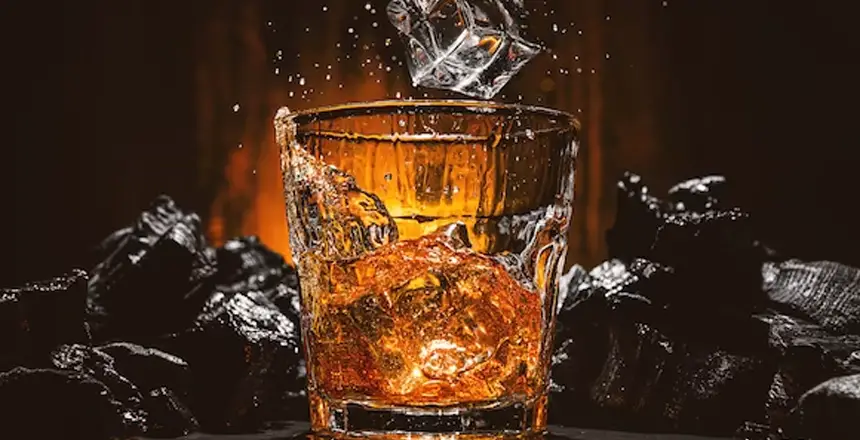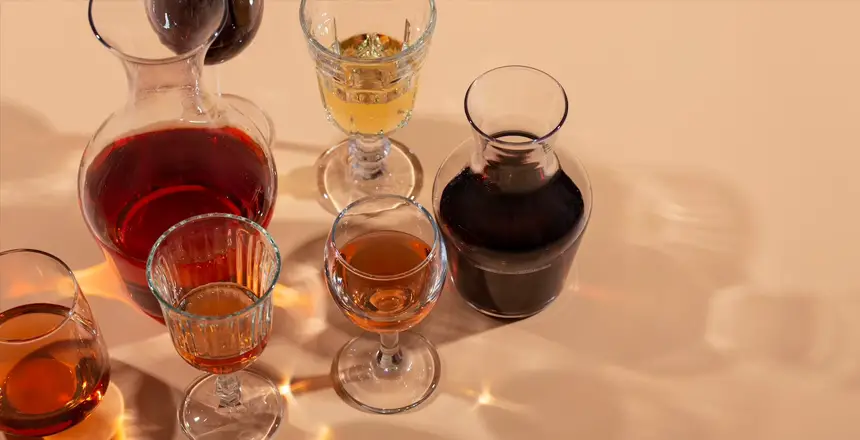Just the thought of whiskey can evoke images of smoky oak barrels and the jovial atmosphere of a lively bar. It’s well known that whiskey can take you on a journey between bold flavors and sweet aromas, but it can be difficult to put into words what exactly makes each sip so unique.
Whether you’re a seasoned whiskey connoisseur or just delving into the world of distilled spirits, today we’ll explore what makes up the flavor profiles of different kinds of whiskeys so you can appreciate their complexity even more.
What Is Whiskey?

Whiskey, also known as whisky in some countries, is a type of distilled alcoholic beverage made from fermented grains, such as barley, corn, rye, and wheat. It is one of the most popular spirits in the world and has been enjoyed for centuries.
The exact origins of whiskey are unclear, but it is believed to have originated in Ireland and Scotland in the early Middle Ages. Over time, whiskey has evolved into different types and styles, such as Scotch, Irish, bourbon, and rye, each with its unique taste and characteristics.
Today, whiskey is enjoyed by millions of people around the world and is often sipped neat, on the rocks, or mixed in cocktails.
Click here in case you want more details on whisky origin.
What Are the Different Types of Whiskey?

Whiskey is a beloved liquor that comes in a range of flavors and varieties, each with its own unique characteristics.
- Bourbon, which is primarily made in Kentucky, is known for its sweetness and smokiness that comes from the oak barrels in which it is aged. Bourbon is made from at least 51% corn
- Scotch, on the other hand, is made in Scotland and known for its bold and peaty flavors. Irish whiskey is smoother and often triple-distilled, giving it a distinct flavor profile.
- Rye, which is made from at least 51% rye grain, is known for its spicy and robust character. Canadian whiskey tends to be milder, with a hint of sweetness.
- Other types of whiskey, such as Canadian and Japanese, have their own nuances and fan bases.
Knowing the different types of whiskey can help you choose the right one for your taste preferences and needs.
What Gives Whiskey Its Flavor?
Whiskey’s flavor is a result of various factors that contribute to its unique taste.
One of the primary factors is the type of grain used in the mash bill, which is a mixture of grains used to create the whiskey. Different grains such as barley, rye, wheat, or corn can be used in varying proportions to produce different types of whiskey with distinct flavor profiles.
Another significant factor is the aging process, where the whiskey is stored in barrels for a specific amount of time.
The type of barrel used can also impact the flavor, as the wood can impart certain characteristics to the whiskey. The charring level of the barrel, climate, and humidity are other environmental factors that can affect the flavor.
By understanding these different factors, one can gain a better appreciation for the complex flavors found in various types of whiskey.
What Does Whiskey Taste Like?
As a seasoned whiskey drinker or a curious novice, you might find yourself wondering what whiskey truly tastes like. Well, the answer to that question is a complex one.
Whiskey is a complex drink that’s influenced by various factors such as the type of grain used, the aging process, and the blending process. When you take a sip of whiskey, you might taste a hint of smoke, sweet caramel or toffee notes, or a touch of fruity or spicy flavors.
- Smoky: Whiskey can have a smoky taste that comes from the charred oak barrels used in the aging process. The longer the whiskey is aged, the smokier it can taste.
- Sweet: Some whiskeys have a sweet taste that comes from the malted barley used in the distillation process. Others may have a sweeter taste from being aged in barrels that previously held wine or sherry.
- Spicy: Whiskey can have a spicy taste that comes from the rye or other grains used in the mash bill. This can range from a subtle hint of spice to a more pronounced flavor.
- Fruity: Some whiskeys have a fruity taste that comes from the esters produced during the fermentation process. This can give the whiskey notes of apple, pear, or other fruits.
- Woody: Whiskey can have a woody taste that comes from the oak barrels used in the aging process. This can range from a subtle hint of wood to a more pronounced flavor.
- Earthy: Some whiskeys have an earthy taste that comes from the peat used to dry the malted barley. This can give the whiskey a smoky, earthy flavor.
- Nutty: Whiskey can have a nutty taste that comes from the toasted grains used in the mash bill. This can give the whiskey notes of almond, hazelnut, or other nuts.
Overall, the taste of whiskey can vary widely depending on factors such as the type of grain used, the aging process, and the type of barrel used.
Tasting notes and flavor profiles can help guide your tasting experience and enhance your appreciation for the complexity of different types of whiskey.
Can You Learn to Taste Whiskey Like a Pro?
Whiskey is a complex beverage that is meant to be savored and appreciated. Developing an expert palate for tasting whiskey takes time and effort, but with the right techniques and tips, anyone can learn how to identify the different flavors and aromas in whiskey like a pro.
To start, it’s important to understand the basics of whiskey tasting, including the importance of nosing and taking small sips.
Additionally, it’s helpful to keep a tasting journal, so you can track your progress and learn from your mistakes. Experimenting with different whiskeys from various regions and distilleries can also help you develop your palate and broaden your whiskey knowledge.
Don’t be discouraged if it takes some time to fully appreciate the nuances of different whiskeys – with practice, patience, and persistence, anyone can learn to taste whiskey like a pro.
We suggest you watch this video for a more detailed guidance from expert on tasting whiskey:
FAQs
What is the difference between whiskey and bourbon?
The main difference between whiskey and bourbon is that bourbon must be made from at least 51% corn and aged in oak barrels, while other types of whiskey can be made with any type of grain.
Can I mix whiskey with other drinks, or is it best to drink it straight?
You can mix whiskey with other drinks, such as ginger ale or cola, to create delicious cocktails. However, it’s important to note that some whiskeys are best enjoyed neat or on the rocks. Experimenting with different combinations is a great way to find out what you like!
What is the best way to taste whiskey for the first time?
When tasting whiskey, it’s important to take your time and appreciate all the different flavors and aromas. Start by taking a small sip of the whiskey neat or on the rocks and then letting it sit in your mouth for a few seconds before you swallow.
Then explore the nose of the whiskey by swirling it in the glass and taking a few short sniffs. With each sip, you should be able to pick up on different flavor notes that make up the whiskey’s unique profile.
What is the ideal temperature to serve whiskey?
The ideal temperature to serve whiskey depends on the type and how it is served. Generally, bourbons and whiskeys that are enjoyed neat or with a splash of water should be served at room temperature or slightly chilled. Meanwhile, whiskeys that are served over ice should be kept cold.
Does the age of the whiskey affect its taste?
Yes, the age of whiskey does affect its taste. Generally, older whiskeys are smoother and more balanced in flavor due to the longer aging period. Younger whiskeys may have a more pronounced burn due to their higher alcohol content.
Can whiskey go bad if it’s been open for a long time?
In general, whiskey does not go bad once it has been opened. However, it should be stored in a cool, dark place and the bottle should be tightly sealed when not in use to ensure that the flavor remains intact.
Take Home Message
With all of these flavors and varieties available to us, it is no wonder why whiskey has had such a long and popular history. Whether you prefer the sweetness of Scotch or the smoky complexity of a Kentucky Straight Bourbon, there is something out there for everyone.
So next time you reach for a glass of whiskey, remember to keep an open mind and look forward to discovering new & exciting flavor profiles! Who knows? Maybe it’ll become one of your favorite drinks! What Does Whiskey Taste Like? | A Guide to the Different Flavors of Whiskey


